This Article was published in the Martinez News-Gazette on 9/24/2017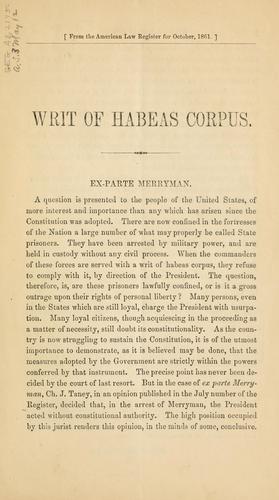 Writ of Habeas Corpus 1861, Courtesy U.S. Library of Congress Writ of Habeas Corpus 1861, Courtesy U.S. Library of Congress Picking up Aaron’s story from where we left off, Aaron Rice had sworn out a Writ of Habeas Corpus against William for the enslavement of Nathaniel (Aaron’s son) on Friday August 10, 1860, issued by elected Napa County Judge Pulaski Jacks. According to Farlex’s Free Online Legal Dictionary, “Habeas Corpus is a writ (court order) that commands an individual or a government official who has restrained another to produce the prisoner at a designated time and place so that the court can determine the legality of custody and decide whether to order the prisoner's release.” William is immediately arrested and forced to appear before the Napa County’s Court of Sessions on Monday August 13, 1860 the first available ordered term. According to the California Research Bureau, “The Courts of Sessions were the earliest county-level courts of record that adjudicated criminal offenses… authorized by the state Constitution.” 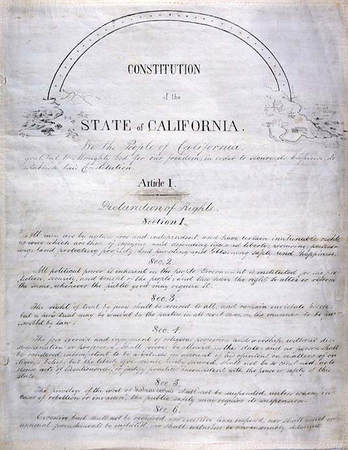 California Constitution 1849, Courtesy California State Archives California Constitution 1849, Courtesy California State Archives From the California Constitution of 1850, Article VI, § 8,“There shall be elected in each of the organized counties of this State, one County Judge, who shall hold his office for four years…The County Judge, with two Justices of the Peace, to be designated according to law, shall hold Courts of Sessions with such criminal jurisdiction as the Legislature shall prescribe, and he shall perform such other duties as shall be required by law.” All of the Justices of the Peace from within the county elected the two Justices of the Peace designated as the Associate Justices of that county’s Courts of Sessions for a term of one year. From the 1850 California State Charter 86 § 5, those powers conferred to the Court of Sessions were the ability to hear, “all cases of assault, assault and battery, breach of the peace, riot, affray, and petit larceny, and over all misdemeanors punishable by fine not exceeding five hundred dollars, or imprisonment not exceeding three months, or both such fine and imprisonment.” 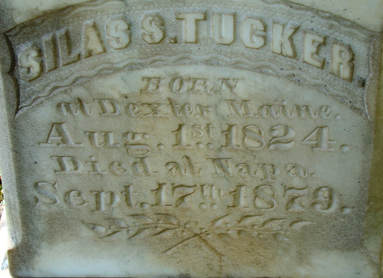 Justice Silas S. Tucker, Tulocay Cemetery Napa, CA Justice Silas S. Tucker, Tulocay Cemetery Napa, CA Here is where it gets interesting, instead of appearing before Judge Jacks who had issued the writ, the case was instead heard by Justice Silas S. Tucker. Who (it should be noted) was not an Associate Justice, had no legal background, and was new to the post of being Napa’s peace officer. Was Judge Jacks docket already full? Why was Aaron’s case not heard then by an Assoc. Justice? Only Judge Jacks had the authority to fill an Assoc. Justice vacancy by appointment, which is perhaps how Justice Tucker came to decide Aaron and Nathaniel’s fate. However, as of today we have found no evidence of this occurrence. 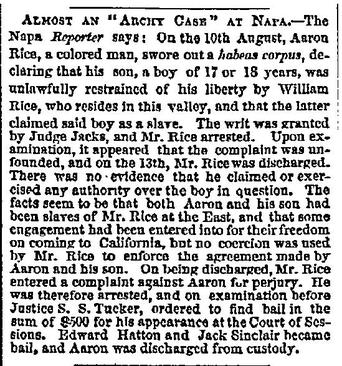 Napa Register Aug. 20, 1860 Napa Register Aug. 20, 1860 Although the official record of the case is presently missing, we do have an account published in the Napa Register on August 20, 1860. It states, “Upon examination, it appeared that the complaint was unfounded, and on the 13th, Mr. Rice was discharged. There was no evidence that he claimed or exercised any authority over the boy in question. The facts seem to be that both Aaron and his son had been slaves of Mr. Rice at the East, and that some engagement had been entered into for their freedom on coming to California, but no coercion was used by Mr. Rice to enforce the agreement against Aaron and his son.” 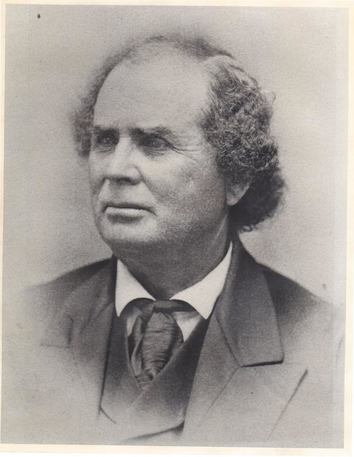 William Rice Courtesy of Friends of Rice-Tremonti Home William Rice Courtesy of Friends of Rice-Tremonti Home Remember neither Aaron nor Nathaniel by California law could legally testify against William. William could say whatever he wanted, not have it challenged and therefor make it the official record of the incident. Although a casual observer would have been able to tell that William was lying and that Nathaniel was indeed enslaved, Justice Tucker ruled in favor of William. Ironically, William immediately files charges of perjury against Aaron. The Napa Register continues, “On being discharged, Mr. Rice entered a complaint against Aaron for perjury. He was therefore arrested, and on examination before Justice S. S. Tucker, ordered to find bail in the sum of $500 for his appearance at the Court of Sessions.” This means Justice Tucker threw the book at Aaron, by charging him with the stiffest penalty he could, (valued at more than $14,000 today). The History of Contra Costa County by W. J. Slocum & Co. supports the newspaper’s version of events stating William, “…was brought to trial at once, the case was dismissed, and the negro mulcted in costs.” The Napa Register account finishes by stating, “Edward Hatton and Jack Sinclair became bail, and Aaron was discharged from custody.” We suspect Aaron was not in custody long, perhaps just over night, but it had to be disconcerting none the less. Edward Hatton and Jack Sinclair had become good friends of Aaron and his family and obviously were not going to let him sit in jail. They actually agreed to $500 worth of their own physical labor in order to secure Aaron’s freedom. How long Nathaniel was forced to stay under William’s custody is yet unknown. However a month later on September 17, 1860, Charlotte (Aaron’s wife) and Robert (his father) bought a 160 acre farm for $100 from William Russell. Perhaps Aaron was left off the deed to prevent William from retaliating and filling a claim on the property. In any case, it is yet another clear indication that Nathaniel was the only family member of Aaron’s left entrapped. On another note (according to inflation calculators) $100 in 1860 would be worth more than $2,800 today or another way of looking at it $100 today would only be worth $3.50 then. This supports our theory that back in July (when they were visited by Rev. Starr King) they didn’t give their monies to William to purchase their freedom. Instead they declared themselves free, invested those monies in themselves and their new fresh start. Back then raising $100 (above and beyond what they would need to cover their living expenses) would have been nearly impossible in that short of time with the limited opportunities available to them. Despite their obvious setbacks, Aaron’s family forged ahead and made a life for themselves in the Great State of California. Lastly the Court of Sessions was abolished by the state legislature with the passage of the 1863 California State Charter 260 §§ 47-53, 89. It replaces them with County Courts, which we know today as our Superior Court system. Judie & Joseph Palmer are two of the founding members of the Martinez Cemetery Preservation Alliance (MCPA) and the Potter’s Field Project. Both have a passion for discovery, history, genealogy, anthropology and archaeology. For more info, please visit our website MartinezCemetery.org. Do you have a Potter’s Field story to tell? We welcome any pictures or information regarding the Alhambra Pioneer Cemetery or its Potter’s Field. Please email us at [email protected] or call us at (925) 316-6069.
|
AuthorsJudie & Joseph Palmer are two of the founding members of the Martinez Cemetery Preservation Alliance (MCPA) and the Potter’s Field Project. Both have a passion for discovery, history, genealogy, anthropology and archaeology. Archives
October 2021
Categories |

 RSS Feed
RSS Feed